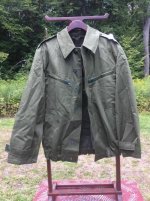dandyrandy
Member
- Joined
- Jul 2, 2016
- Messages
- 620
- Reaction score
- 884
Hello and thank you all for having me here! Ive bought/collected a lot of this old military surplus and had a question about asbestos dangers in this gear. I feel this will be a particular important thread because it could possibly save peoples lives from dangerous asbestos fibers. All of you Im sure are at least aware of the dangers of asbestos and most of it has been banned (NOT ALL) in most countries. However lots of old Cold War era Soviet Bloc stuff can be highly questionable.
My question today is does anybody have any knowledge or experience in any of this military surplus and know what to look for that could possibly have asbestos in it? What is in question today is this Cold War Era Soviet Bloc jacket. The liner in particular. Its a Hungarian Army jacket M65??? (not sure exactly) with an outer and inner liner. From what I gather its from the 70s to 80s time frame and cant find much info on it from the surplus supplier. Ill add pictures if im able to for you to see below.


Im only aware of the Cold War Era gas mask cartridges containing asbestos and also fire retardant clothing from WW1 and 2. Thats all that I know to watch out for on the used military surplus market. If any of you are aware of ANY surplus that has asbestos in it please post your comments below. Any help would be greatly appreciated and potentially save peoples lives. Thanks!
My question today is does anybody have any knowledge or experience in any of this military surplus and know what to look for that could possibly have asbestos in it? What is in question today is this Cold War Era Soviet Bloc jacket. The liner in particular. Its a Hungarian Army jacket M65??? (not sure exactly) with an outer and inner liner. From what I gather its from the 70s to 80s time frame and cant find much info on it from the surplus supplier. Ill add pictures if im able to for you to see below.


Im only aware of the Cold War Era gas mask cartridges containing asbestos and also fire retardant clothing from WW1 and 2. Thats all that I know to watch out for on the used military surplus market. If any of you are aware of ANY surplus that has asbestos in it please post your comments below. Any help would be greatly appreciated and potentially save peoples lives. Thanks!
